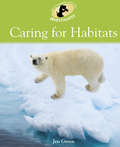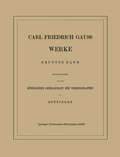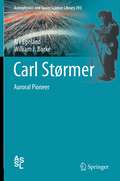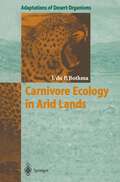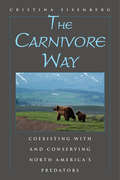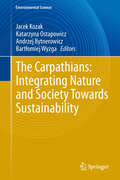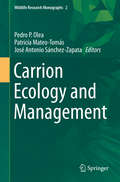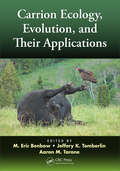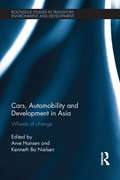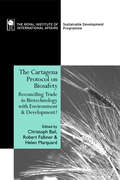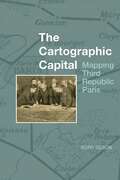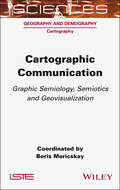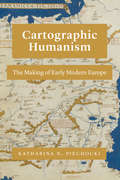- Table View
- List View
Caring For Habitats: Caring For Habitats (library Ebook (Environment Detective Investigates #2)
by Jen GreenWhat is a habitat?Why are habitats under threat?How can we help to take care of habitats?The Environment Detective Investigates helps you to answer these questions and many more about habitats. Find out about the different habitats on Earth, what harm pollution is doing to habitats and why they need our protection.
Caring for the Earth: A strategy for sustainable living (Sustainable Development Set)
by The World (Iucn) Unep Wwf'This is a strategy for a kind of development that provides real improvements in the quality of human life and at the same time conserves the vitality and diversity of the Earth. The goal is development that will be sustainable. Today it may seem visionary. but it is attainable. To more and more people it also appears our only rational option.' – from Chapter 1 in 1980, the International Union for Conservation of Nature and Natural Resources, the United Nations Environment Programme and the World Wide Fund for Nature, the world's three most powerful organizations dedicated to preventing environmental catastrophe, published the World Conservation Strategy. It stressed the interdependence of conservation and development, it gave currency to the idea of sustainable development and it made the point that unless the vitality and productivity of the planet are safeguarded, the future for humanity is at risk. Its impact was immediate and worldwide. Now, ten years later, the same three organizations have formulated a new strategy for the 19905. Caring for the Earth builds on all that has been learned in the last decade about the complexity of the problems and shows how radical and far-reaching are the actions and objectives needed to meet them. Nothing less than a new ethic is required, based on affirming the community of life and cherishing its diversity – an ethic which has to be reflected in our personal attitudes and the organization of our communities as much as in wider policies. Public participation is essential for the success of the strategy, which is addressed to individuals and citizens' groups as well as to governments - whatever their systems. Adopting it will not be easy, but it does provide the agenda for immediate action. Originally published in 1991
Caring for the Earth: A strategy for sustainable living (Sustainable Development Set)
by The World (Iucn) Unep Wwf'This is a strategy for a kind of development that provides real improvements in the quality of human life and at the same time conserves the vitality and diversity of the Earth. The goal is development that will be sustainable. Today it may seem visionary. but it is attainable. To more and more people it also appears our only rational option.' – from Chapter 1 in 1980, the International Union for Conservation of Nature and Natural Resources, the United Nations Environment Programme and the World Wide Fund for Nature, the world's three most powerful organizations dedicated to preventing environmental catastrophe, published the World Conservation Strategy. It stressed the interdependence of conservation and development, it gave currency to the idea of sustainable development and it made the point that unless the vitality and productivity of the planet are safeguarded, the future for humanity is at risk. Its impact was immediate and worldwide. Now, ten years later, the same three organizations have formulated a new strategy for the 19905. Caring for the Earth builds on all that has been learned in the last decade about the complexity of the problems and shows how radical and far-reaching are the actions and objectives needed to meet them. Nothing less than a new ethic is required, based on affirming the community of life and cherishing its diversity – an ethic which has to be reflected in our personal attitudes and the organization of our communities as much as in wider policies. Public participation is essential for the success of the strategy, which is addressed to individuals and citizens' groups as well as to governments - whatever their systems. Adopting it will not be easy, but it does provide the agenda for immediate action. Originally published in 1991
Caring Management in the New Economy: Socially Responsible Behaviour Through Spirituality (Palgrave Studies in Sustainable Business In Association with Future Earth)
by Ora Setter László ZsolnaiThis edited book frames a new ethos of management that cares for society, future generations and nature whilst also serving the interests of business and the wider community. Employing the practical wisdom of faith traditions, the chapters develop the use of spirituality as a resource for creating business models that take pressing social problems – such as quality of life at work, over-consumption, environmental degradation and climate change – into account. Spanning entrepreneurship, leadership, management education and business models, the chapters in this book aim to develop a spiritually-based caring model of management to face the challenges and reality of the 21st century.
Carl Størmer: Auroral Pioneer (Astrophysics and Space Science Library #393)
by Alv Egeland William J. BurkeThis biography summarizes the seminal contributions to auroral and space science of Carl Størmer (1874 - 1957). He was the first to develop precise photographic methods to calculate heights and morphologies of diverse auroral forms during four solar cycles. Størmer independently devised numerical techniques to determine the trajectories of high-energy charged particles allowed and forbidden in the Earth’s magnetic field. His theoretical analyses explained cosmic ray access to the upper atmosphere, 20 years before they were identified by other scientists. Størmer’s crowning achievement, “The Polar Aurora,” published when he was 81 years old, stands to this day as a regularly cited guide in graduate-level courses on space physics. The authors present the life of this prodigious scientist in relation to the cultural life of early 20th century in Norway and to the development of the space sciences in the post-Sputnik era.
Carleman Estimates and Applications to Inverse Problems for Hyperbolic Systems (Springer Monographs in Mathematics)
by Mourad Bellassoued Masahiro YamamotoThis book is a self-contained account of the method based on Carleman estimates for inverse problems of determining spatially varying functions of differential equations of the hyperbolic type by non-overdetermining data of solutions. The formulation is different from that of Dirichlet-to-Neumann maps and can often prove the global uniqueness and Lipschitz stability even with a single measurement. These types of inverse problems include coefficient inverse problems of determining physical parameters in inhomogeneous media that appear in many applications related to electromagnetism, elasticity, and related phenomena. Although the methodology was created in 1981 by Bukhgeim and Klibanov, its comprehensive development has been accomplished only recently. In spite of the wide applicability of the method, there are few monographs focusing on combined accounts of Carleman estimates and applications to inverse problems. The aim in this book is to fill that gap. The basic tool is Carleman estimates, the theory of which has been established within a very general framework, so that the method using Carleman estimates for inverse problems is misunderstood as being very difficult. The main purpose of the book is to provide an accessible approach to the methodology. To accomplish that goal, the authors include a direct derivation of Carleman estimates, the derivation being based essentially on elementary calculus working flexibly for various equations. Because the inverse problem depends heavily on respective equations, too general and abstract an approach may not be balanced. Thus a direct and concrete means was chosen not only because it is friendly to readers but also is much more relevant. By practical necessity, there is surely a wide range of inverse problems and the method delineated here can solve them. The intention is for readers to learn that method and then apply it to solving new inverse problems.
Carnival Caricatures: Carnival and Humor in Rio de Janeiro, Brazil (The Latin American Studies Book Series)
by Fabiana Lopes da CunhaThis work analyzes carnival in Rio de Janeiro through the irreverent view disclosed by the illustrated Brazilian magazines Fon-Fon! and Careta. For such purpose, texts and illustrations elaborated by great names in caricature and literature were used, as well as by journalists who remained anonymous due to the fact that their chronicles and articles did not carry their signatures. The way in which carnival was dealt with in said publications, was intimately related to the world view which intellectuals enjoyed, the Belle Epoque, and to the readers of these magazines: the urban middle classes and part of the elite. To understand both the view and the type of humoristic approach used, songs and the works of chronicle writers, memorialists and historians who worked on the theme were also investigated. At the end, what could be verified through the study of these publications was the importance that carnival enjoyed in the lives of those men of letters and brushes, and how relevant was the counterpart which they made possible not only to readers, but also to us, historians. Through these publications, it is possible to redeem and reconstruct part of the history of carnival as well as understand the context of the period, political problems, stylishness, innovations and changes in the lives of Rio de Janeiro (carioca) dwellers. So much attention to the theme from the illustrated press denotes the importance of carnival to the financial health of newspaper companies, since the subject and its well-humored approach pleased readers, besides showing that not only did those writers and artists write about the festivities in an irreverent manner, but they also actively participated in them as carnival merrymakers, and therefore they were, themselves, artificers of that history.
Carnivore Ecology in Arid Lands (Adaptations of Desert Organisms)
by Jacobus du BothmaArid lands require that organisms inhabiting them be well-adapted to thrive or even just to survive. This book provides a review of the ecological adaptations - be they behavioural, physiological or morphological - of carnivores to arid environments. Following a general introduction into aridity and arid lands in Africa, the major carnivore families are presented. Ecological adaptations of carnivores in arid lands reveal the amplitude and resilience of the ecology of these animals. In setting up conservation measures, the nature and extent of such adaptations are important facets in determining the effective area and degree of heterogeneity required as habitat by a carnivore population so as to produce a viable unit.
The Carnivore Way: Coexisting with and Conserving North America's Predators
by Cristina EisenbergWhat would it be like to live in a world with no predators roaming our landscapes? Would their elimination, which humans have sought with ever greater urgency in recent times, bring about a pastoral, peaceful human civilization? Or in fact is their existence critical to our own, and do we need to be doing more to assure their health and the health of the landscapes they need to thrive? In The Carnivore Way, Cristina Eisenberg argues compellingly for the necessity of top predators in large, undisturbed landscapes, and how a continental-long corridor—a “carnivore way”—provides the room they need to roam and connected landscapes that allow them to disperse. Eisenberg follows the footsteps of six large carnivores—wolves, grizzly bears, lynx, jaguars, wolverines, and cougars—on a 7,500-mile wildlife corridor from Alaska to Mexico along the Rocky Mountains. Backed by robust science, she shows how their well-being is a critical factor in sustaining healthy landscapes and how it is possible for humans and large carnivores to coexist peacefully and even to thrive.University students in natural resource science programs, resource managers, conservation organizations, and anyone curious about carnivore ecology and management in a changing world will find a thoughtful guide to large carnivore conservation that dispels long-held myths about their ecology and contributions to healthy, resilient landscapes.
The Carpathians: Integrating Nature and Society Towards Sustainability (Environmental Science and Engineering)
by Jacek Kozak, Katarzyna Ostapowicz, Andrzej Bytnerowicz and Bartłomiej WyżgaThe book includes a broad spectrum of perspectives from different scientific disciplines (both the natural and social sciences) as well as practical knowledge. It gives a new insight into the Carpathian mountain region
Carrion Ecology and Management (Wildlife Research Monographs #2)
by Pedro P. Olea Patricia Mateo-Tomás José Antonio Sánchez-ZapataCarrion, or dead animal matter, is an inherent component of aquatic and terrestrial ecosystems worldwide, and is exploited by a wide diversity of organisms from different trophic levels, including microbes, arthropods and vertebrates. Further, carrion consumption by scavengers, i.e. scavenging, supports key ecosystem functions and services such as recycling nutrients and energy, disposing of carcasses and regulating disease spread. Yet, unlike dead plant matter, dead animal decomposition has received little attention in the fields of ecology, wildlife conservation and environmental management, and as a result the management of carrion for maintaining biodiversity and functional ecosystems has been limited. This book addresses the main ecological patterns and processes relating to the generation and consumption of carrion both in terrestrial and aquatic ecosystems. It also discusses a number of conservation concerns and associated management issues, particularly regarding the increasing role of human-mediated carrion in ecosystems. Lastly, the book outlines future research lines in carrion ecology and management, and identifies the major challenges for scavengers and scavenging processes in the Anthropocene.
Carrion Ecology, Evolution, and Their Applications
by M. Eric Benbow Jeffery K. Tomberlin Aaron M. TaroneShortlisted for the 2018 TWS Wildlife Publication Awards in the edited book categoryDecomposition and recycling of vertebrate remains have been understudied, hampered largely due to these processes being aesthetically challenging (e.g., smell and sight). Technological innovations have provided the means to explore new and historically understo
Cars, Automobility and Development in Asia: Wheels of change (Routledge Studies in Transport, Environment and Development)
by Arve Hansen and Kenneth Bo NielsenCars, Automobility and Development in Asia explores the nexus between automobility and development in a pan-Asian comparative perspective. The book seeks to integrate the policies, production forms, consumption preferences and symbolism implicated in emerging Asian automobilities. Using empirically rich and grounded analyses of both comparative and single-country case studies, the authors chart new approaches to studying automobility and development in emerging Asia.
Cars, Automobility and Development in Asia: Wheels of change (Routledge Studies in Transport, Environment and Development)
by Arve Hansen Kenneth Bo NielsenCars, Automobility and Development in Asia explores the nexus between automobility and development in a pan-Asian comparative perspective. The book seeks to integrate the policies, production forms, consumption preferences and symbolism implicated in emerging Asian automobilities. Using empirically rich and grounded analyses of both comparative and single-country case studies, the authors chart new approaches to studying automobility and development in emerging Asia.
The Cartagena Protocol on Biosafety: Reconciling Trade in Biotechnology with Environment and Development
by Christoph Bail Robert Falkner Helen MarquardModern biotechnology - the controversial manipulation of genes in living organisms - has far-reaching implications for agriculture, human health, trade and the environment. Against the odds, an international treaty governing biosafety and trade in biotechnology was adopted in 2000. The Cartagena Protocol on Biosafety of the Convention on Biological Diversity deals with one of the most important and challenging issues thrown up by developments in biotechnology. This volume is a comprehensive review of the protocol and the process that led to its adoption. It includes contributions from many of the key players involved and analyses the commercial and political interests at stake, the operations and implications of the protocol, and prospects for the future.
Cartesian Currents in the Calculus of Variations II: Variational Integrals (Ergebnisse der Mathematik und ihrer Grenzgebiete. 3. Folge / A Series of Modern Surveys in Mathematics #38)
by Mariano Giaquinta Guiseppe Modica Jiri SoucekNon-scalar variational problems appear in different fields. In geometry, for in stance, we encounter the basic problems of harmonic maps between Riemannian manifolds and of minimal immersions; related questions appear in physics, for example in the classical theory of a-models. Non linear elasticity is another example in continuum mechanics, while Oseen-Frank theory of liquid crystals and Ginzburg-Landau theory of superconductivity require to treat variational problems in order to model quite complicated phenomena. Typically one is interested in finding energy minimizing representatives in homology or homotopy classes of maps, minimizers with prescribed topological singularities, topological charges, stable deformations i. e. minimizers in classes of diffeomorphisms or extremal fields. In the last two or three decades there has been growing interest, knowledge, and understanding of the general theory for this kind of problems, often referred to as geometric variational problems. Due to the lack of a regularity theory in the non scalar case, in contrast to the scalar one - or in other words to the occurrence of singularities in vector valued minimizers, often related with concentration phenomena for the energy density - and because of the particular relevance of those singularities for the problem being considered the question of singling out a weak formulation, or completely understanding the significance of various weak formulations becames non trivial.
A Cartographic Analysis of Soviet Military City Plans (Springer Theses)
by Martin DavisThe collapse of the Soviet Union has seen the emergence of its unprecedentedly comprehensive global secret military mapping project and the commercial availability of a vast number of detailed topographic maps and city plans at several scales. This thesis provides an in-depth examination of the series of over 2,000 large-scale city plans produced in secret by the Military Topographic Directorate (Военное топографическое управление) of the General Staff between the end of the Second World War and the collapse of the USSR in 1991. After positioning the series in its historical context, the nature and content of the plans are examined in detail. A poststructuralist perspective introduces possibilities to utilise and apply the maps in new contexts, which this thesis facilitates by providing a systematic, empirical analysis of the Soviet map symbology at 1:10,000 and 1:25,000, using new translations of production manuals and a sample of the city plans. A comparative analysis with the current OpenStreetMap symbology indicates scope for Soviet mapping to be used as a valuable supplementary topographic resource in a variety of existing and future global mapping initiatives, including humanitarian crisis mapping. This leads to a conclusion that the relevance and value of Soviet military maps endure in modern applications, both as a source of data and as a means of overcoming contemporary cartographic challenges relating to symbology, design and the handling of large datasets.
The Cartographic Capital: Mapping Third Republic Paris, 1889-1934 (Studies in Modern and Contemporary France #1)
by Kory OlsonThrough official maps, this book looks at how government presentations of Paris and environs change over the course of the Third Republic (1889-1934). Governmental policies, such as the creation of a mandatory national uniform educational system that will eventually include geography, combined with technological advances in the printing industry, to alter the look, exposure, reception, and distribution of government maps. The government initially seemed to privilege an exclusively positive view of the capital city and limited its presentation of it to land inside the walled fortifications. However, as the Republic progressed and Paris grew, technology altered how Parisians used and understood their urban space. Rail and automobiles made moving about the city and environs easier while increased industrialization moved factories and their workers further out into the Seine Department. During this time, maps transitioned from reflecting the past to documenting the present. With the advent of French urbanism after World War I, official mapped views of greater Paris abandoned privileging past achievements and began to mirror actual residential and industrial development as it pushed further out from the city centre. Finally, the government needed to plan for the future of greater Paris and official maps begin to show how the government viewed the direction of its capital city.
Cartographic Communication: Graphic Semiology, Semiotics and Geovisualization
by Boris MericskayThis book deals with the geological record and the evolution of ideas concerning the Variscan orogenic belt in France and neighboring regions. Volume 1 is based on a general introduction concerning the imprint of the Variscan period on the geology of France, as well as on the particularities of the study of this ancient orogen. A history of the concepts applied to the Variscan belt is proposed in order to consider this orogen in the history of Earth Sciences. A paleogeodynamic analysis of the Variscan cycle sets the general framework for the evolution of the orogen, which is then tackled through the prism of the magmatic, metamorphic and tectonic record of the early phases (from Cambrian to Lower Carboniferous). Volume 2 proposes an analysis of the late evolution of the Variscan orogenic belt, reflecting its dismantling in a high-temperature context during the Upper Carboniferous and Permian. The sedimentary archives are described, as well as the questions raised by the specificities of this ancient orogen.
Cartographic Communication: Graphic Semiology, Semiotics and Geovisualization
by Boris MericskayThis book deals with the geological record and the evolution of ideas concerning the Variscan orogenic belt in France and neighboring regions. Volume 1 is based on a general introduction concerning the imprint of the Variscan period on the geology of France, as well as on the particularities of the study of this ancient orogen. A history of the concepts applied to the Variscan belt is proposed in order to consider this orogen in the history of Earth Sciences. A paleogeodynamic analysis of the Variscan cycle sets the general framework for the evolution of the orogen, which is then tackled through the prism of the magmatic, metamorphic and tectonic record of the early phases (from Cambrian to Lower Carboniferous). Volume 2 proposes an analysis of the late evolution of the Variscan orogenic belt, reflecting its dismantling in a high-temperature context during the Upper Carboniferous and Permian. The sedimentary archives are described, as well as the questions raised by the specificities of this ancient orogen.
Cartographic Humanism: The Making of Early Modern Europe
by Katharina N. PiechockiWhat is “Europe,” and when did it come to be? In the Renaissance, the term “Europe” circulated widely. But as Katharina N. Piechocki argues in this compelling book, the continent itself was only in the making in the fifteenth and sixteenth centuries. Cartographic Humanism sheds new light on how humanists negotiated and defined Europe’s boundaries at a momentous shift in the continent’s formation: when a new imagining of Europe was driven by the rise of cartography. As Piechocki shows, this tool of geography, philosophy, and philology was used not only to represent but, more importantly, also to shape and promote an image of Europe quite unparalleled in previous centuries. Engaging with poets, historians, and mapmakers, Piechocki resists an easy categorization of the continent, scrutinizing Europe as an unexamined category that demands a much more careful and nuanced investigation than scholars of early modernity have hitherto undertaken. Unprecedented in its geographic scope, Cartographic Humanism is the first book to chart new itineraries across Europe as it brings France, Germany, Italy, Poland, and Portugal into a lively, interdisciplinary dialogue.
Cartographic Humanism: The Making of Early Modern Europe
by Katharina N. PiechockiWhat is “Europe,” and when did it come to be? In the Renaissance, the term “Europe” circulated widely. But as Katharina N. Piechocki argues in this compelling book, the continent itself was only in the making in the fifteenth and sixteenth centuries. Cartographic Humanism sheds new light on how humanists negotiated and defined Europe’s boundaries at a momentous shift in the continent’s formation: when a new imagining of Europe was driven by the rise of cartography. As Piechocki shows, this tool of geography, philosophy, and philology was used not only to represent but, more importantly, also to shape and promote an image of Europe quite unparalleled in previous centuries. Engaging with poets, historians, and mapmakers, Piechocki resists an easy categorization of the continent, scrutinizing Europe as an unexamined category that demands a much more careful and nuanced investigation than scholars of early modernity have hitherto undertaken. Unprecedented in its geographic scope, Cartographic Humanism is the first book to chart new itineraries across Europe as it brings France, Germany, Italy, Poland, and Portugal into a lively, interdisciplinary dialogue.
Cartographic Humanism: The Making of Early Modern Europe
by Katharina N. PiechockiWhat is “Europe,” and when did it come to be? In the Renaissance, the term “Europe” circulated widely. But as Katharina N. Piechocki argues in this compelling book, the continent itself was only in the making in the fifteenth and sixteenth centuries. Cartographic Humanism sheds new light on how humanists negotiated and defined Europe’s boundaries at a momentous shift in the continent’s formation: when a new imagining of Europe was driven by the rise of cartography. As Piechocki shows, this tool of geography, philosophy, and philology was used not only to represent but, more importantly, also to shape and promote an image of Europe quite unparalleled in previous centuries. Engaging with poets, historians, and mapmakers, Piechocki resists an easy categorization of the continent, scrutinizing Europe as an unexamined category that demands a much more careful and nuanced investigation than scholars of early modernity have hitherto undertaken. Unprecedented in its geographic scope, Cartographic Humanism is the first book to chart new itineraries across Europe as it brings France, Germany, Italy, Poland, and Portugal into a lively, interdisciplinary dialogue.
Cartographic Humanism: The Making of Early Modern Europe
by Katharina N. PiechockiWhat is “Europe,” and when did it come to be? In the Renaissance, the term “Europe” circulated widely. But as Katharina N. Piechocki argues in this compelling book, the continent itself was only in the making in the fifteenth and sixteenth centuries. Cartographic Humanism sheds new light on how humanists negotiated and defined Europe’s boundaries at a momentous shift in the continent’s formation: when a new imagining of Europe was driven by the rise of cartography. As Piechocki shows, this tool of geography, philosophy, and philology was used not only to represent but, more importantly, also to shape and promote an image of Europe quite unparalleled in previous centuries. Engaging with poets, historians, and mapmakers, Piechocki resists an easy categorization of the continent, scrutinizing Europe as an unexamined category that demands a much more careful and nuanced investigation than scholars of early modernity have hitherto undertaken. Unprecedented in its geographic scope, Cartographic Humanism is the first book to chart new itineraries across Europe as it brings France, Germany, Italy, Poland, and Portugal into a lively, interdisciplinary dialogue.
